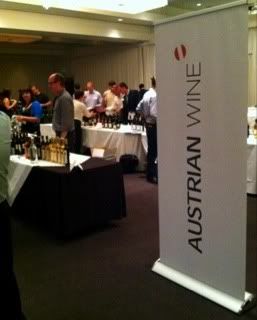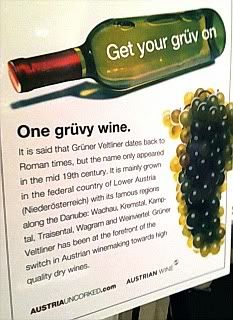The Danube River flows through Central Europe for over 1,700 miles - from the Black Forest to the Black Sea. Along the way are wine regions producing wines which can legitimately be called hidden gems. The wines of Austria, Hungary, Slovenia and Croatia are well worth exploring for the taste alone. The sense of history that comes with each sip is a bonus. You can also find an easy way to add some exotic grapes to your Century Club efforts.
The Blue Danube Wine Company is a wine distributor with a mission. The San Francisco-based wholesaler is bent on making wine lovers of the United States aware of the fine wines they import from Central Europe, from those hidden gem areas along the blue Danube.
At the recent Port4lio tasting event in Culver City, California, I had the chance to sample from a literal smorgasbord of wines featuring producers, grapes and wine regions with which I had little experience - and even less success in pronouncing. Fortunately, Blue Danube’s Frank Dietrich and Stetson Robbins were there to help out the tasters with pours and pronunciation.
Juris Winery is near Gols, Austria - just southeast of Vienna near the Neusiedler See. Winemaker Axel Stiegelmar (right) was on hand to present his wines personally.
Stiegelmar talked of his four-story winery, which utilizes gravity to help make a smaller carbon footprint. He talked of his family’s winemaking tradition, which dates back to the 1500s.. What he really loves to talk about are his grapes, mainly St. Laurent, Pinot Noir, Chardonnay and Sauvignon Blanc. For this event, Stiegelmar poured his red wines.
The Juris ‘10 Zweigelt lives up to the expectations held by lovers of this grape. The smoky nose, the earthy fruit, the firm tannins and razor-sharp acidity all contribute on the way to the incredible finish. More strong earthiness comes on the nose of the ‘09 St. Laurent, which leads to a beautiful sour cherry flavor.
The Juris reserve wines are made from older vines. Stiegelmar says, “the vines are mature enough so the roots have reached down below the top layer of soil into the mineral layer below.” The mineral aspect does come through significantly on the ‘08 Pinot Noir Reserve, along with raspberry and strawberry and a mouth-watering acidity. The ‘09 St. Laurent Reserve shows great minerals and sour cherry on the palate.
A beautiful blend - the Juris ‘09 Ina Mera is 40% Cabernet Sauvignon,, 30% Merlot and 30% Blaufrankisch. It is very clean and earthy with bright acidity. The wine is playful in the mouth with a long, gorgeous finish.
Slovenian producer Batic - an organic estate in the Vipava Valley - covered a wide range of styles with just a few wines. The Batic ‘06 Pinot Gris tastes like candied green apples. The ‘08 Pinela - a grape grown only in this small area - is a refreshing white with great acidity. The ‘09 Cabernet Franc shows dense forest fruit on the nose and a taste of tart raspberry. As I found over and over at this event, the wine has excellent acidity.
Also from Slovenia, Kabaj - pronounced ka-bay - is located in the far western part of the country, immediately next to Italy, in the Goriska Brda region. Two whites produced with skin contact presented intense minerals. The ‘09 Beli Pinot is a Pinot Blanc possessing an earthy acidity, while the ‘09 Sivi Pinot is a Pinot Grigio exploding with minerals, earth and green apples.
Coastal Croatian Reds included one from Terzolo, in Istria. The ‘09 Teran was described by Robbins as “a masochistic wine.” It is a bit tannic, but I didn’t feel I was looking for trouble by enjoying it.
Bibich produces wine in Skradin, North Dalmatia. Their ‘09 R6 Riservo - made of Babich, Lasin and Plavina grapes - is very old world, with high acidity and nervy, savory flavors.
Dingac Winery, from the Peljesac Peninsula of Dalmatia, poured several wines made from Plavic Mali, the Croatian version of Zinfandel. Their ‘10 Plavac is surprisingly smooth for a grape that is known for its tannic nature. The ‘10 Peljesac is a little bigger and shows some spiciness, while the ‘08 Postup has a big mineral display.
There were some lovely sparkling wines, too. Törley - Hungary’s famous sparkling wine producer - had four bubblies represented. Gala blends Chardonnay, Pinot Noir, Riesling and Királyleányka. Fresh apples grace the nose and palate. Fortuna - Muskat Ottonel, Irsal Olivér and Muskat Lunel - is fabulously sweet. More sweetness comes from Hungaria Grand Cuvée brut, a Chardonnay, Pinot Noir and Riesling blend. It captivates with a beautiful, sweet floral expression. The Tokaji has beautiful sweetness tempered by a healthy dollop of minerality.
Kogl - from Štajerska, Slovenia - went the other way with it. The non-vintage Albus Clasique of Riesling, Yellow Muskat, Chardonnay and Furmint grapes is a dry sparkler showing earthy minerals and toast. The non-vintage Rubellus Clasique is made from Pinot Noir as a rosé. It has a nice, funky, toasty nose with a beautiful and elegant on the palate.
If you want a real education in the wines of Central Europe, a visit to the Blue Danube website is an absolute must.
Follow Randy Fuller on Twitter

 As is the case at wine tasting events where there is a proliferation of one particular type of wine, I experienced palate fatigue and the Gruner Veltliners all started to taste the same. I've experienced the same thing at events that were heavy on Pinot Noir, Tempranillo and Albarino. Mixing it up made for a good palate cleanser. I'd taste whites for a while, then reds, then back to whites. I even went across the property and sampled a few Ribera Tempranillos at another event going on at the same time. As good as those Spanish wines were, I didn't stay long. I couldn't wait to get back to Austria.
As is the case at wine tasting events where there is a proliferation of one particular type of wine, I experienced palate fatigue and the Gruner Veltliners all started to taste the same. I've experienced the same thing at events that were heavy on Pinot Noir, Tempranillo and Albarino. Mixing it up made for a good palate cleanser. I'd taste whites for a while, then reds, then back to whites. I even went across the property and sampled a few Ribera Tempranillos at another event going on at the same time. As good as those Spanish wines were, I didn't stay long. I couldn't wait to get back to Austria. As I mentioned earlier, the wines of
As I mentioned earlier, the wines of